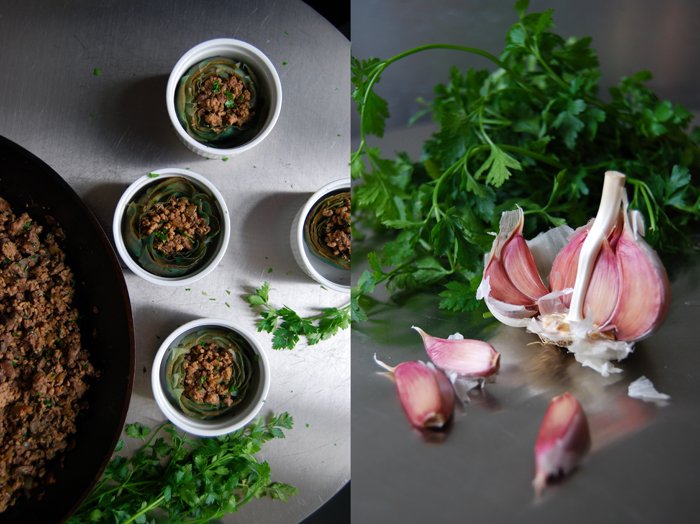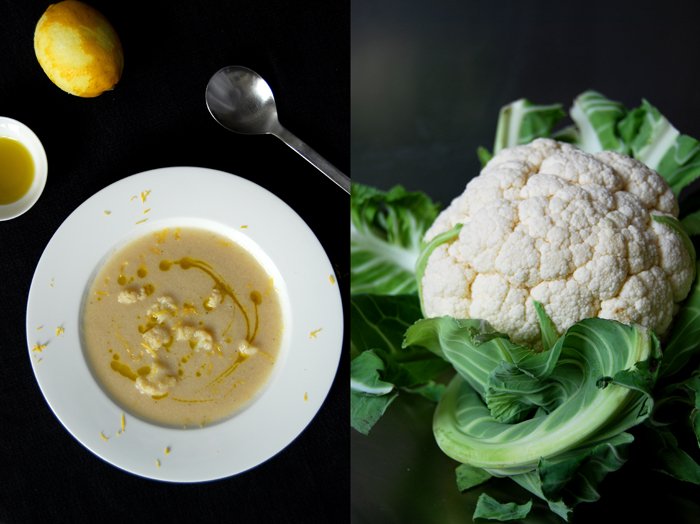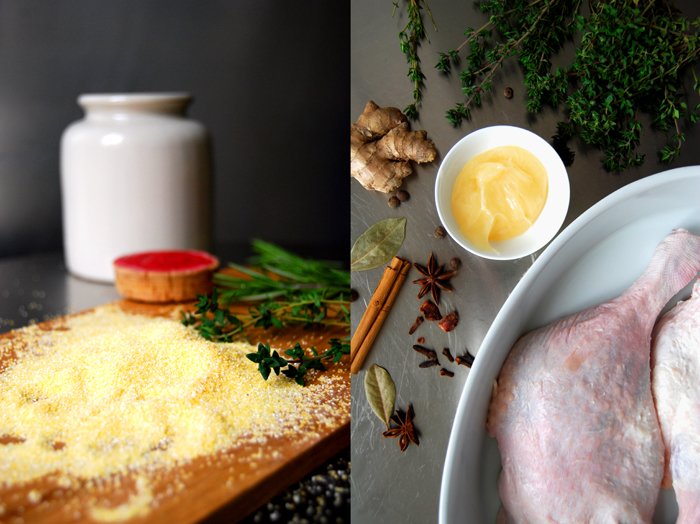Stuffed Maltese Artichokes with Meat and Brandy
In Maltese cuisine, stuffed vegetables have a long tradition. The island's soil and climate offer the right conditions for fruits and vegetables to grow and ripen under the Mediterranean sun with strong tastes and in huge quantities. Tomatoes, onions, marrows, zucchini, aubergines, pumpkins, all fruits and vegetables that are perfect to be filled! Be it with meat, seafood, herbs or other vegetables, you can combine flavours of all kinds or even use your leftovers to create a completely new dish you would have never thought of before. When I'm in an experimental mood, I bravely mix whatever I find in my fridge and shelves, sweet, sour, spicy or bitter, I've never been disappointed, but often surprised!
A few weeks ago I wrote about my stuffed zucchini, the filling was light and fluffy, made of ricotta, basil and lemon, perfect for the fruit's soft taste. When I decided to stuff some baby artichokes I had a stronger filling in mind, hearty, with minced pork and chicken liver which is an old, traditional Maltese recipe. To refine the meat's flavours I deglazed it with sweet brandy and infused it with an aromatic bay leaf and a pinch of cumin. I prepared everything in advance and warmed it up in the oven for a few minutes before dinner, in my little ramekins. The meal pretty and delicious!
Stuffed Artichokes with Minced Pork, Chicken Liver and Brandy
The artichokes can be prepared in advance and warmed up in the oven before serving.
For 6 stuffed baby artichokes you need
baby artichokes 6
minced pork 220g / 8oz
chicken liver, cleaned and finely chopped, 150g / 5 1/2oz
medium sized onion, finely chopped, 1
garlic, crushed, 2 cloves
brandy 40ml / 1 1/2fl oz
white wine 160ml / 5 1/2fl oz
bay leaf 1
cumin, ground, a pinch
parsley, chopped, the leaves of a small bunch
salt and black pepper
olive oil
juice of 1/2 lemon
Cut off the artichoke stems. If they are soft, peel and chop them finely and set aside. Pluck the hard outer leaves and cut the artichokes' tips off (1/3 – 1/2 of the artichoke), just the soft, fleshy part of the leaves should be left. Loosen the hairy choke with a knife and scoop it out with a spoon. Keep the prepared artichokes in a bowl of cold water and the juice of half a lemon once they are cut.
In a large pot, cook the artichokes in lots of salted water for about 10 minutes or until soft.
Set the oven to 200°C /390°F.
In a large heavy pan, heat a splash of olive oil and sauté the onion and garlic on medium for a few minutes until soft. If the artichoke stems are soft add them as well. Add a little more olive oil and fry the minced meat for 2-3 minutes. Add the liver, stir and fry for a minute. Add the bay leaf, parsley and cumin, deglaze with brandy and pour in the white wine, cook it down for 2 minutes. Season with salt and pepper and fill the artichokes with the minced meat mixture.
Place the artichokes in a big baking dish or 6 single ramekins, add a dash of white wine to cover the bottom of the dish and cook them in the oven for 5 minutes.
Carnival and a Cauliflower Soup with Ginger and Lemon
A couple weeks ago I wrote about our traditional family feast, a time when we all meet at my mother's house in the countryside to celebrate carnival. It's always silly, loud and involves lots of good food. The festive highlight is the making of our Berliner which involves each family member. A Berliner is a sweet speciality which looks a bit like a doughnut without a hole. It’s made of yeast dough, filled with jam, deep fried in vegetable shortening and sprinkled with cinnamon icing sugar. The jam filling changes with the years, a few weeks ago I filled mine with blueberry jam which became my favourite (for now), they tasted divine! The reason I made them at my home without my family before carnival, was a blog tour I was asked to joined. I decided to share our "Berliner" family tradition. I made them on my own for the first time in my life, they were as good as at my mother's but it's more fun with family and friends.
In the end it turned out to be (subconsciously) a wise choice as this carnival will be different. This year there is neither a family feast nor a Berliner to enjoy, for us it's soup instead. A wisdom tooth got in our way and needed to come out quick. Needless to say, a jam filled Berliner isn't the appropriate food in a situation like this, porridge and soup is more like it!
I have a big, beautiful cauliflower in the kitchen, a cabbage I don't use so often but in a velvety soup it shows its finer qualities. The sweet taste and smooth texture is great for puréed soups. I don't add any cream, just broth, onion, garlic and some tangy flavours, lemon and ginger. A piece of ginger simmers together with the cauliflower in the broth before I season it with grated ginger to taste. I add the lemon's juice and zest when the soup is done, arrange it in plates drizzled with some good olive oil and sprinkle some more lemon zest on top. I'm impressed, it's still smooth but fresh!
Last week I told you that eat in my kitchen was nominated for The Kitchn's Best Daily Read Cooking Blog Award 2014. Food52 won the award but I want to thank you all for your support and all your votes, with your help eat in my kitchen reached the final!
Ginger Lemon Cauliflower Soup
For 4 people you need
a big cauliflower, rinsed and cut into 5cm / 2" pieces, around 750g / 1.5 pounds (weight without stem)
vegetable broth 1500ml
onion, chopped, 1
garlic, cut in half, 1
bay leaf 1ginger, thumbnail sized piece plus 1 teaspoon grated
lemon juice 1 tablespoon
lemon zest 1 teaspoon
salt and black pepper
olive oil for frying and topping
In a large pot, fry the onion and garlic in a little oil until golden and soft. Add the cauliflower, bay leaf, the piece of ginger and broth and bring to the boil. Cook for 10 minutes or until the cauliflower is al dente. When it's done take out the bay leaf and ginger and put a few smaller pieces of cauliflower (a small plate full) aside before you mix the soup in a blender. Season with salt, pepper, the grated ginger, lemon juice and zest and put the cauliflower pieces back into the smooth soup. When you arrange the plates, drizzle some good olive oil on top and sprinkle with some lemon zest.
A Purple Risotto with Bitter Radicchio
When it comes to risotto I like the rice to have a bit of bite, with a velvety texture and not too liquid. I always make mine with broth and wine adding a little at a time so that I don't miss the point of my favoured texture. What's great about this meal is that it's made of ingredients which I usually have in stock. There are always one or two vegetables in my fridge waiting to be used and Arborio rice, onions, garlic, olive oil and wine to cook is on my shelves anyway. So it's perfect for an indecisive day when I don't know what to put on my cooker, or I don't have the time to think about dinner. Conveniently, it's also ready in half an hour!
My purple risotto has a biting bitterness from the radicchio which combines very well with the thyme. The rice is infused with the strong flavours in my broth and spices. I use a bay leaf and cloves which introduce a woody element to the bitterness (although that sounds strange, it describes it best!). When I cook with radicchio I like to have a strong counterpart to balance out its dominant character.
Radicchio Risotto with Spices and Thyme
For 2 hungry people you need
Arborio rice 200g / 7 ounces
radicchio, quartered and cut into slices, 1 medium sized head (I cut a few radicchio slices very thinly which I leave uncooked for the topping)
onion, chopped finely, 1
garlic, cut in half, 1 clove
red wine around 200ml
broth 1200-1500ml
fresh thyme leaves from 4-6 sprigs
bay leaf 1
cloves 2
salt and black pepper
olive oil for frying
butter 1 tablespoon
In a large pot, fry the onions and garlic in a little olive oil until golden and soft, stir in the rice and radicchio and fry on medium temperature for a couple minutes. Deglaze with 1/3 of the wine, let it cook until evaporated and repeat twice, stirring in between. Add 4 sprigs of the thyme, the spices, salt and pepper and some of the stock, enough to cover the rice. The temperature should be between low and medium. When the liquid has been absorbed continue to add more broth, a little at a time stirring in between. Depending on the rice, it sometimes needs more or less liquids. When the rice is al dente and the broth is more or less absorbed take it off the heat, take out the spices, stir in the butter and season with salt and pepper to taste. Arrange on plates sprinkled with the uncooked radicchio slices and some thyme leaves.
Ginger Honey Glazed Duck with Spices and Polenta
Sometimes I don't have the time or patience to slow cook a whole duck for hours like I do with my Christmas Duck. Although this really makes for the most tender and juicy meat, I need a quicker alternative. Here's what I came up with, honey glazed duck legs, juicy as well, with crisp skin, rubbed with spices and - most importantly - you can enjoy all of this after about an hour. If I find the time I marinade the meat in the morning so that the flavours can spread and soak into the skin during the day but it's great either way.
I prefer the darker, deeper meat of wildfowl like duck, goose and pheasant, especially in the cold season. They allow you to rub strong spices and herbs into their skin without loosing their own qualities. For my duck legs, I went for an aromatic mixture of clove, bay leaf, ginger, star-anis, thyme, allspice and a good amount of honey for a crispy caramelized skin. The juices made an amazing sauce, a concentrate of all the spices, I just added some red wine. Perfect to dip the polenta in which I seasoned with thyme and rosemary.
GingerHoney Glazed Duck with Spices and Polenta with Thyme and Rosemary
I prepare the polenta around 4o minutes after I put the duck legs into the oven.
For 2 people you need
duck legs 2
red wine 250ml (or 100ml red wine and 150ml broth)
salt and black pepper
olive oil
For the marinade
aromatic honey 2 tablespoons
ginger, thumbnail sized, grated
thyme, leaves of 5 sprigs
allspice berries, ground, 3
cloves, ground, 5
bay leaf, ground, 1
star-anis, ground, 1
cinnamon, ground, 1/4 teaspoon
Warm up the honey in a small sauce pan until it becomes liquid, spread on the duck legs together with the spices and rub everything into their skin marinating them for 1 hour (if possible). You can also prepare them in the morning (like I do) and keep them in the fridge all day before you cook them in the evening.
For the duck legs
Set the oven to 260°C / 500°F. My oven has a Rotitherm roasting setting which works perfectly for poultry.
Put the duck legs into an oiled baking dish, skin side up, and season with salt and pepper. Pour the remaining honey and spices of the marinade over the duck and place the dish in the hot oven. When the skin starts to get brown after a few minutes turn the temperature down to 130°C / 265°F and pour the red wine into the baking dish (a little over the duck as well) and bake for 60 minutes. Check with a skewer, if only clear juices come out the duck is done. Keep the duck legs in a warm place, pour the juices into a sauce pan and season with salt and pepper to taste. I didn't even need to cook the sauce down. It was perfect, very intense, it didn't need anything else. If you like you can add some more honey, Balsamico or a little orange juice.
For the polenta
polenta 120g / 4 ounces
water 250ml plus 150ml for cooking
milk 250ml
thyme, leaves of 4 sprigs
rosemary, chopped, 1/2 - 1 teaspoon
salt 1 teaspoon
olive oil 2 tablespoons
In a sauce pan, mix 250ml of water with the milk and salt and bring to the boil. Take the pan off the heat, add the olive oil, polenta and herbs and mix with a whisk. Turn down the heat to the lowest temperature and put the pan back on. Cook the polenta for 10 minutes mixing and adding the rest of the water once in a while.
Salmon with a Crust of Winter Spices
Salmon is great to combine with strong flavours. Its own taste is so strong and unique but blends in perfectly with all kinds of herbs and spices, even exotic curry mixtures. When I saw this nice salmon steak at the fish counter I had to buy it. I didn't even plan to cook fish but it looked too good to pass by.
At the moment, I use a lot of juniper, bay leaves and cloves, the typical winter spices. I decided to give them a try on the salmon as well - as a rough crust. They are very strong and aromatic spices, a bit sweet and smoky. It was more an experiment of sorts but I was really impressed by the result. We ate it with fresh bread and a salad on the side. Enjoy a glass of white wine with your meal and you will have a small dose of summer in January!
Salmon with a Crust of Bay Leaf, Juniper and Clove
For 2 people you need
salmon steak, around 2cm / 3/4" thick, 1 big or 2 smaller steaks
olive oil
juice of 1/2 a lemon
For the crust
garlic, crushed, 1 clove
bay leaves, ground in a mortar, 2
juniper berries, ground in a mortar, 2
cloves, ground in a mortar, 2
black pepper, ground in a mortar, 6
Set your oven to 200°C / 390°F.
Grind all the ingredients for the crust in a mortar until you have a combined paste. Heat some oil in a non-stick pan (highest temperature). Rinse and dry the fish, season with salt and pepper and fry for 1 minute (on each side). Take the fish off the heat and spread the paste on the top side of the steak. Pour a bit of oil in a baking dish, mix with the lemon juice and place your salmon steak on top. Bake in the oven for 8 minutes, when you can lift the fish from the bones it’s done.















